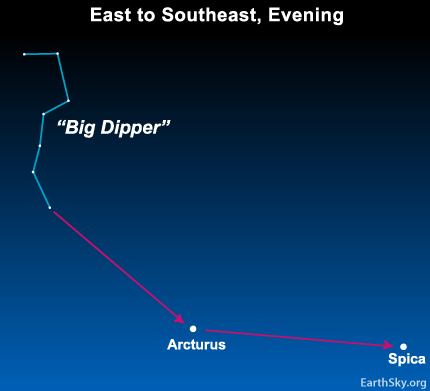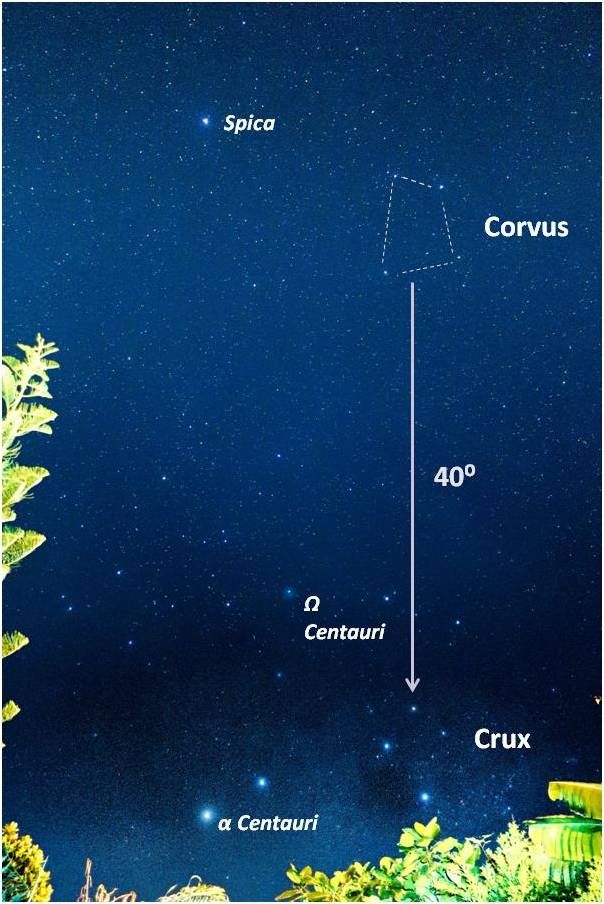A favorite constellation for many, little squarish Corvus the Crow, can be found after sunset at this time of year. It’s not far from Spica, the only bright star in the constellation Virgo. Once you find Spica, you’ll recognize Corvus easily. It’s always near the star Spica on the sky’s dome, recognizable for its compact, boxy shape. Spica is supposed to represent an Ear of Wheat, held by Virgo the Maiden. With a good imagination and a dark-enough sky, you can almost see Corvus as a real crow, pecking toward Spica, trying to snatch the wheat.
And thus the stories of the heavens were born …
You don’t need Corvus to identify the bright star Spica. You can use the Big Dipper for that as shown on the diagram below:

Use the handle of the Big Dipper to locate the stars Arcturus and Spica. Just follow the arc in the Dipper’s handle. And remember the phrase “follow the arc to Arcturus, and drive a spike to Spica.”
After you find Spica, Corvus is easy. It’s right next to the bright star, a small boxy pattern that’s noticeable to the eye. Because Corvus is such an easy and fun constellation to pick out in the sky, there are many legends in skylore about it. A lovely one comes from China, where this grouping of stars was seen as an imperial chariot, riding on the wind. In ancient Israel, and sometimes in Greek mythology, Corvus was said to be a raven, not a crow. The early Greeks saw Corvus as a cupbearer to Apollo, god of the sun. The website Constellation-guide.com explains that Corvus was:
… Apollo’s sacred bird in Greek mythology. According to the myth, the raven originally had white feathers. In one story, Apollo told the bird to watch over Coronis, one of his lovers, who was pregnant at the time.
Coronis gradually lost interest in Apollo and fell in love with a mortal man, Ischys. When the raven reported the affair to Apollo, the god was so enraged that the bird did nothing to stop it that he flung a curse on it, scorching the raven’s feathers. That, the legend goes, is why all ravens are black.
Corvus is a friendly sight in the heavens. Along with all the stars, Corvus’s stars will be found a bit farther west at nightfall in the coming weeks and months as Earth moves around the sun. Check it out now and watch for it in the next few months.
The bright star Spica – near Corvus on our sky’s dome – will always be there to guide your eye.

View at EarthSky Community Photos. | Dr Ski in Valencia, Philippines wrote: “Corvus (the Crow) and Crux (the Southern Cross) are at the same right ascension on the celestial sphere. Meaning, they transit the meridian at the same time (approximately 8:30 p.m. local time or 9:30 p.m. local daylight saving time). If you reside in mid-northern latitudes … look for the familiar polygon of Corvus at this time. Then extrapolate a line approximately 40° down to get an idea of how far below your horizon the Southern Cross is.” If you’re further south, of course, as Dr Ski is … just look!
Bottom line: Use the star Spica to introduce yourself to the constellation Corvus the Crow.
Enjoying EarthSky so far? Sign up for our free daily newsletter today!
from EarthSky https://ift.tt/3g6dUgq
A favorite constellation for many, little squarish Corvus the Crow, can be found after sunset at this time of year. It’s not far from Spica, the only bright star in the constellation Virgo. Once you find Spica, you’ll recognize Corvus easily. It’s always near the star Spica on the sky’s dome, recognizable for its compact, boxy shape. Spica is supposed to represent an Ear of Wheat, held by Virgo the Maiden. With a good imagination and a dark-enough sky, you can almost see Corvus as a real crow, pecking toward Spica, trying to snatch the wheat.
And thus the stories of the heavens were born …
You don’t need Corvus to identify the bright star Spica. You can use the Big Dipper for that as shown on the diagram below:

Use the handle of the Big Dipper to locate the stars Arcturus and Spica. Just follow the arc in the Dipper’s handle. And remember the phrase “follow the arc to Arcturus, and drive a spike to Spica.”
After you find Spica, Corvus is easy. It’s right next to the bright star, a small boxy pattern that’s noticeable to the eye. Because Corvus is such an easy and fun constellation to pick out in the sky, there are many legends in skylore about it. A lovely one comes from China, where this grouping of stars was seen as an imperial chariot, riding on the wind. In ancient Israel, and sometimes in Greek mythology, Corvus was said to be a raven, not a crow. The early Greeks saw Corvus as a cupbearer to Apollo, god of the sun. The website Constellation-guide.com explains that Corvus was:
… Apollo’s sacred bird in Greek mythology. According to the myth, the raven originally had white feathers. In one story, Apollo told the bird to watch over Coronis, one of his lovers, who was pregnant at the time.
Coronis gradually lost interest in Apollo and fell in love with a mortal man, Ischys. When the raven reported the affair to Apollo, the god was so enraged that the bird did nothing to stop it that he flung a curse on it, scorching the raven’s feathers. That, the legend goes, is why all ravens are black.
Corvus is a friendly sight in the heavens. Along with all the stars, Corvus’s stars will be found a bit farther west at nightfall in the coming weeks and months as Earth moves around the sun. Check it out now and watch for it in the next few months.
The bright star Spica – near Corvus on our sky’s dome – will always be there to guide your eye.

View at EarthSky Community Photos. | Dr Ski in Valencia, Philippines wrote: “Corvus (the Crow) and Crux (the Southern Cross) are at the same right ascension on the celestial sphere. Meaning, they transit the meridian at the same time (approximately 8:30 p.m. local time or 9:30 p.m. local daylight saving time). If you reside in mid-northern latitudes … look for the familiar polygon of Corvus at this time. Then extrapolate a line approximately 40° down to get an idea of how far below your horizon the Southern Cross is.” If you’re further south, of course, as Dr Ski is … just look!
Bottom line: Use the star Spica to introduce yourself to the constellation Corvus the Crow.
Enjoying EarthSky so far? Sign up for our free daily newsletter today!
from EarthSky https://ift.tt/3g6dUgq

Aucun commentaire:
Enregistrer un commentaire